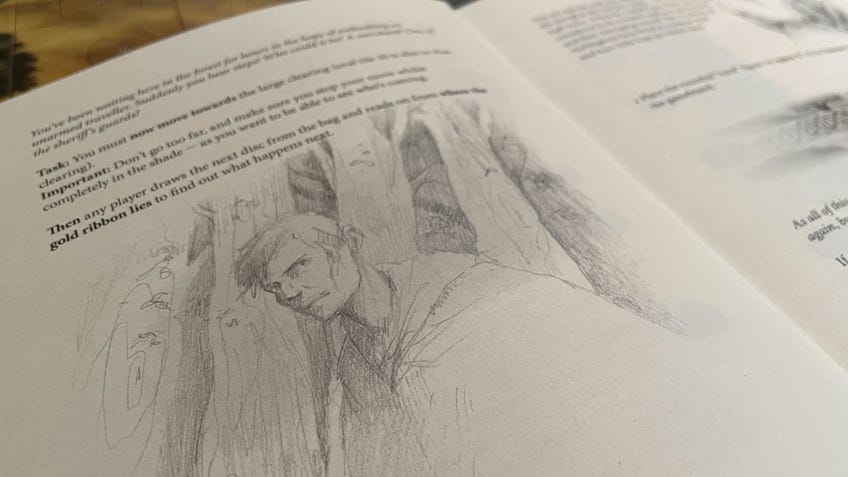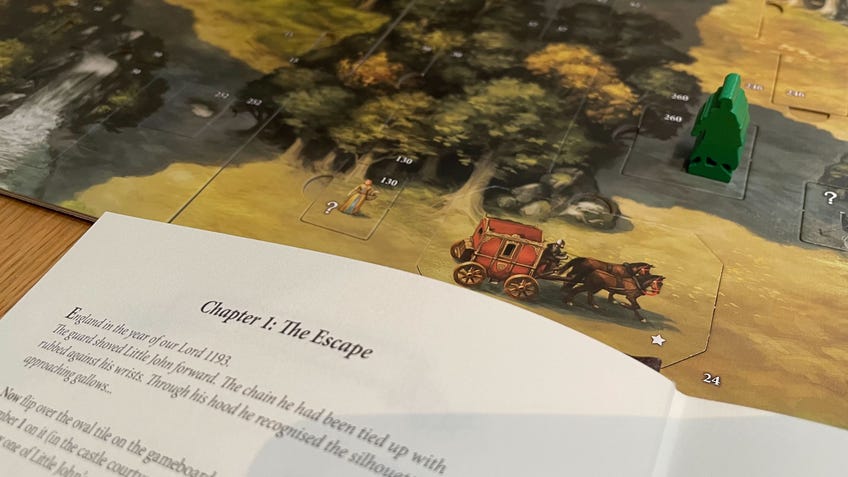The Adventures of Robin Hood’s choose-your-own-adventure story and tactile board make it a surprisingly innovative family game
I Sherwood like to play some more.
The Adventures of Robin Hood is a co-op board game for up to four players that takes place in - as you’d expect - the town and surrounding landscape of Nottingham during the 11th century. As Robin and his allies Little John, Will Scarlett and Maid Marian, the players progress through a series of scenarios, each one loosely based on the legend of the green vigilante. While the initial setup of The Adventures of Robin Hood is far from the most original, the experience of playing the game is another thing entirely.
Almost immediately the first thing you notice when you unpack The Adventures of Robin Hood is the game’s board. As soon as I saw that board, I knew we wouldn’t be playing an ordinary co-op game. Depicting Sherwood Forest, part of Nottingham town and the castle, the board features a multitude of flippable pieces. When you first bring the board out all of these pieces will be facing up one way, but as you play through each scenario the board will gradually change to reflect the events in the game. For example, if the players have searched a particular spot or taken a certain item, the board will change to indicate that something has appeared or disappeared in those locations.

The game’s introductory scenario sees Little John incarcerated within the Castle of Nottingham due to his association with the notorious Robin of Locksley. As Little John and Robin Hood – as well as Maid Marian and/or Will Scarlett if your group has more than two players – the party needs to ensure that Little John escapes the walls of Nottingham Castle. The co-op game invites players to turn over certain parts of the board in order to spawn the guards standing watch in and around the castle, presenting players with their first challenge.
The movement gameplay in The Adventures of Robin Hood ties in nicely with the overall feeling of immersion in the game’s story.
As Little John, the player will need to find a way out of the castle by searching their surroundings, all the while remaining out of guards’ sight. Meanwhile, Robin will need to make their way over to Nottingham Castle in order to meet with John in a secure location once he’s free. Both these objectives will require players to move around the board using their movement rulers. Every player has three of these rulers, with one being slightly longer than the other two. By placing their movement rulers in a line from the stationary meeple currently on the board, players can travel across the board, ending with their other stationary meeple. Whenever players do this, they need to take into account the environment depicted on the board, such as trees or buildings.
The movement gameplay in The Adventures of Robin Hood is not only a unique way of approaching the act of moving across a board – far more than just picking up a meeple and placing it somewhere else – it ties in nicely with the overall feeling of immersion in the game’s story. Having to physically track out your movement one meeple at a time, navigating around the objects on the board and avoiding clearings containing guards makes it feel more like you are actually Robin Hood and Little John. Being able to interact with things on the board, like removing a rope from a noose and using it to grapple down a wall, only further adds to the story immersion.
The whole experience flows very nicely, largely thanks to how straightforward the actual gameplay mechanics are.
Players narrate the game’s story by reading it from a physical hardcover book, which includes both the events of the plot and instructions on what players need to do to complete a scenario. When certain requirements are met – whether through the players’ actions or through the passing of game rounds – the player in charge of narration will have to read a new passage or turn a page to outline changes to both the story and any gameplay rules. For instance, the arrival of Prince John at Nottingham Castle caused hope in the town – a resource that, when depleted, can lead to defeat – to go down. This arrival was also reflected on the board itself, with tiles being flipped to represent the journey of the price’s carriage to the castle.

Whenever players investigate something on the board they must read the related passage in the book, which explains what happens when they interact with it and how it affects their progress - almost like a classic Fighting Fantasy book. Players can also ‘save’ their progress by using different-coloured bookmarks, allowing them to return to the main quest whenever they’ve finished a board encounter. The whole experience, which feels distinct from many other co-op board games I’ve played, flows very nicely, largely thanks to how straightforward the actual gameplay mechanics are.
Though The Adventures of Robin Hood looks like an unremarkable board game from the outside, it’s one of the most interesting titles I’ve played in a while and has the potential to provide families with a tabletop experience that’s both accessible and unforgettable.

